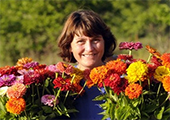- Succession-Planting Interval Chart for Herbs
- Growing Herbs in Containers | Tips for Production of Professional-Quality Container Herbs
- Herb Culture | Comparison Chart (PDF)
- Beyond Cilantro: Top 5 Culinary Herb Trends
- Mouthwatering Combinations: Culinary Herbs + Farm-Fresh Produce
- Destination Herb Farms: Hospitality Farming & Agritourism
- Growing Herb Plants for Direct-Market Sales
- Economic Outlook for Culinary Herbs
- Marketing Herb Plants | Building a Brand for Your Herb Business
- Overwintering Perennial Herbs
- Turning a Profit by Growing Herbs | The Useful Plants
Protecting Valuable Herbs Beyond Their Comfort Zones
Some of the most valuable herbs are perennials that are not hardy in Zones 5 and colder, especially if they don't have sufficient snow cover to protect them. By growing them in an unheated hoophouse or high tunnel under row cover, you can keep these valuable plants alive through extreme cold.
That's what Karma and Michael Glos of Kingbird Farm in Berkshire, New York, discovered when they received a Sustainable Agriculture Research and Education (SARE) grant to research overwintering of perennial herbs.
The Gloses built an unheated greenhouse, 30' x 96', with an inflated double layer of poly. They planted in-ground beds and installed a data logger to monitor temperatures outside, inside, and under row cover suspended on wire hoops.
The Town of Berkshire is in Hardiness Zones 5a, 5b, and 6a. That winter, the Gloses recorded their lowest outdoor winter temperature at -22.3°F/-5.39°C. The temperature inside the unheated hoophouse at that time was 3.2°F/-16°C. Beneath the row cover, the ambient temperature was 14.9°F/-9.47°C and the soil temperature was 33.1°F/0.61°C.
The varieties of herbs they grew included rosemary 'Arp' and lavender 'Lady' and 'Hidcote'. They also grew French tarragon; purple sage; pineapple mint; oregano; and lemon thyme.
After experimenting with straw mulch and row cover, they concluded that they got the best results from just row cover. Plants tended to suffer from mold and were slower to recover in spring when mulched. With one layer of Agribon+ AG-19 suspended above the plants on wire hoops, the farmers recorded more than 95% winter survival of all their herbs. As a result, they were able to make cuttings for plant sales and to sell fresh-cut herbs from April through December.
Byczynski and her family have been growing vegetables and cut flowers since 1988, selling through CSAs, at farmers' markets, to chefs, grocery stores, and florists. They currently grow cut flowers and hoophouse tomatoes on about 2 acres of their 20-acre farm near Lawrence, Kansas.
She is also the author/editor of two of our favorite books about market farming, The Flower Farmer and The Hoophouse Handbook.



